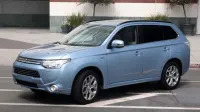Mitsubishi Outlander PHEV sales reach 33,000 worldwide

The breakdown is that Mitsubishi has delivered 15,000 units in Japan and 18,000 in Europe. Fuminori Kojima, Mitsubishi Motors North America’s senior manager of incentives, told AutoblogGreen that the country with the highest sales rate in Europe is Holland, with about 6,000 units sold that thanks in part to generous incentives for plug-in hybrids there. The Euro-spec version on hand in San Jose has three regen levels (the normal D mode, plus B1 and B2). We got to take a spin around the block, but the battery was mostly depleted (it was a popular attraction in the Ride & Drive) and so we were driving on gas.
In the gallery from Plug In 2014, you’ll note that the Outlander PHEV requires at least 95 octane (RON) unleaded fuel, which is 91 octane (AKI) premium fuel in the US. We don’t know what the US version will need, but we’ve heard it will be “completely different.” The Outlander has a 12-kWh battery and should have an EV range of around 30 miles. Whether or not it will have a CHAdeMO fast-charging port in the US is still undecided, as is the question of whether it will have a 3.3 or 6.6 kW onboard charger.
The timeline Kojima gave for the Outlander’s US arrival was October or November of 2015, since the SUV still needs to be tested and homologated for the US, Kojima said, but the real problem is that Mitsubishi can’t build enough. “The battery production capacity is limited,” he said. “So that’s why, [the] first [focus is the] domestic market and Europe showed more demand.” As as an example, he mentioned not only the incentives but also said that the charging infrastructure is more built up in Europe. “We’d like to have it [in the US ] as soon as possible, of course,” he said.
According to numbers from the European group Transport And Environment (see press release and sales chart below), overall plug-in vehicle sales have been doubling each year since the new breed was introduced in 2010. Last year, almost 50,000 plug-in vehicles were sold in the EU, with the Renault Zoe EV, Outlander PHEV and Volvo V60 Plug-in at the top of the pack.

Brussels – for immediate release
Sales of electric vehicles (EVs) have doubled annually in Europe since they were first marketed in 2010, the electrification section of T&E’s cars and CO2 report reveals. In 2013, provisional sales data from the European Environment Agency show that nearly 50,000 plug-in vehicles were sold, representing around 0.4% of all car sales in the EU.
The top three selling EV models in 2013 were all new entrants to the market (Renault Zoe, Mitsubishi Outlander and Volvo V60 Plug-in). In contrast, sales of the best-selling models in 2012 (Opel Ampera and Peugeot Citroen iOn / C-zero ) both fell significantly.
“Electric vehicles can play an important role in the shift to more sustainable mobility, and their increasing sales are being driven by carmakers’ need to innovate to meet EU CO2 regulations,” said Greg Archer of Transport & Environment.
The report highlights the importance of establishing new car emissions standards for 2025 and 2030 to ensure investment in low-carbon vehicles technologies is maintained. It warns that proposals by German carmakers to include transport in the Emissions Trading Scheme (ETS) would lead to higher transport emissions, more oil imports and less innovation in low carbon vehicle technologies because the ETS wouldn’t require emissions reductions in the transport sector.
“Including transport in the Emissions Trading Scheme would put a brake on low carbon vehicle innovation. Emissions standards complemented by targets for ultralow carbon efficient cars will ensure the current rapid pace of innovation is maintained,” Archer concluded.
The report shows sales of electric cars in Europe represent around a quarter of global sales. Sales in California are the highest in the world driven by a mandatory but tradeable requirement on carmakers to supply small numbers of these vehicles. T&E advocate a similar policy for the EU rather than encouraging EV sales through the flawed system of ‘supercredits’ that simply reduce the need for carmakers to improve the efficiency of conventional vehicles.
Cars are responsible for 15% of Europe’s total CO2 emissions and are the single largest source of emissions in the transport sector. The EU’s first obligatory rules on carbon emissions require car manufacturers to limit their average car to a maximum of 130 grams of CO2 per km by 2015, and 95g by 2021.




